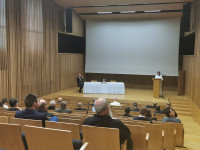Ordine et disciplina reformare
Our Archives organised a conference of church history entitled “Ordine et disciplina reformare – Religious reforms in Hungary” on 16 September 2022 in the ceremonial hall of the Benedictine Secondary School in Pannonhalma with the aim of discussing the religious reforms of the past millennium in 18 presentations. The conference was related to the Archabbey’s actual thematic year of spirituality-and-culture whose motto was “renewal”. As it was expected, the conference proved to be an exciting intellectual experience: analysing the religious institutional system, the participants obtained a horizontal and vertical insight into the spiritual and ecclesiastical processes of the past millennium. Archabbot Cirill T. Hortobágyi’s word of welcome was followed by two introductory presentations (Hedvig Deák OP, Máté Gárdonyi) on the theology of religious renewal, and the change of the concept of ‘reform’ and its broader contexts in church history. There were four presentations on late mediaeval religious orders. Kornél Szovák focused on the Benedictines, Gábor Sarbak on the Paulines, Antal Molnár on the Franciscans, and Balázs Zágorhidi Czigány on the Dominicans as for their aspirations to and results of renewal. In addition to the instances of parallelism, many interesting different aspects were revealed. In the 17th and 18th centuries, the Benedictine and the Pauline renewal took place in different ways (Tamás Dénesi and Anita Bojtos). The renewal of the Benedictine monasticism (which was terminated at the end of the 16th century) could only be realised with the help of the Order’s international network on the basis of new principles; and the Paulines (adapting themselves to the circumstances of the age) chose new tasks and a new aspect. In the Age of Enlightenment, the power of the monarch controlled the life of the religious orders more and more; the Piarists were tightly regulated in their prime (Barnabás Szekér), and the Benedictines were dissolved. The Jesuits were dissolved by the pope due to the pressure of many states. As a consequence of the restoration, the Jesuits created an institutional system fundamentally different from the earlier one (Dániel Siptár), and the Benedictines were given a new line of duty, which required the reconsideration of their monastic life (Lőrinc Biriszló OSB). The end-of-19th-century renewal of the Dominicans was discussed by Mirjam Magyar OP, that of the Franciscans by Peregrin Kálmán OFM, and that of the Piarists by András Koltai. As for the latter two Orders, the reform kept running even at the beginning of the 20th century. Ádám Somorjai OSB surveyed the apostolic visitation in Hungary started in 1927 and its circumstances related to many religious Orders, and Tibor Halász outlined the Cistercians’ process of renewal based on the visitation of 1938. Fülöp Kisnémet OSB presented the aspiration to renewal in the decade following the Second Vatican Council from the point of view of the Benedictines, the Franciscans, and the Piarists, the three religious Orders for men surviving after 1950 and running schools. The conference was concluded with the presentation of Asztrik Várszegi OSB, who included his personal experiences into the religious Orders’ history of restart after 1989. The edited papers of the presentations would be published in a conference-volume next year, thus the thoughts shared in Pannonhalma can reflect upon each other again and they can echo in the minds of the readers.
